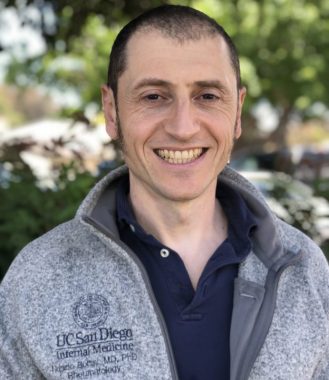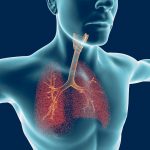Scleroderma Research Is Not Slowing Down

Although rheumatologists specializing in scleroderma are rare like the disease, they have something in common: passion. They’re passionate about understanding and managing the disease and compassionate toward those it affects.
Dr. Nunzio Bottini is one of the foremost scleroderma researchers on the West Coast of the U.S. He obtained his MD and PhD at the University of Rome in Italy, and completed his rheumatology fellowship at the University of California, San Diego, where he is a professor of medicine and rheumatology section head at the Division of Rheumatology, Allergy and Immunology.
We recently asked Dr. Bottini about his work in scleroderma research and other topics. Excerpts follow.
DCW: You’re originally from Italy. What foods do you miss most?
NB: Roman pizza and rosetta bread rolls (which is typical of modern Rome, but different from what was distributed in the Colosseum in ancient Rome, in case you were wondering).

Dr. Nunzio Bottini at UCSD in 2020. (Courtesy of Dr. Nunzio Bottini)
Scleroderma is a rare disease. What prompted you to move into that field of study?
The first time I saw a scleroderma patient I was 23 and found myself just trying to wrap my mind around that clinical picture; she was so different and complex compared to the other rheumatology patients I had seen. It was a new diagnosis, and I remember my surprise and upset when I heard my attending tell the patient there was nothing we could offer to modify her disease course. It was over 25 years ago, things are different now, but there is still much left to do.
What draws you to the research side?
I am no different from other scientists who work on human diseases. We all want to make a difference for the patients. You can definitely make an impact in the clinic, and indeed I love seeing patients in the office. However, scleroderma is a disease where knowledge of mechanisms is still limited. Applying to scleroderma the incredible technology and conceptual advancements that have revolutionized other biomedicine fields in the last decade could be transformational. Key discoveries are rare to come by and take time to become therapies, but when it happens, it impacts many more patients [than] one provider can see in their lifetime!
Please explain how fibroblasts and the novel anti-fibrotic therapies can affect scleroderma.
Many patients with scleroderma present to rheumatologists and pulmonologists with already some ongoing scarring of skin or internal organs. The fibroblast is the cell type in charge of depositing collagen during tissue scarring. In scleroderma, the fibroblast is not the only player; however, in patients who already have an ongoing scarring process, there is [an] agreement that stopping deposition of collagen by fibroblasts and/or reducing fibroblast burden is a valuable target.
Another valuable but understudied area is to understand how scarring can be modified over time to treat already established fibrosis. Scar modification can occur in scleroderma skin and also physiologically in other settings — for example, in surgical scars that initially are more prominent. Then, they can get softer and less “scarry” over time.
We study biochemical signaling pathways inside fibroblasts and other cells, trying to identify pathways that are abnormal during fibrosis and/or can be targeted to reduce the abnormal tendency of fibroblasts to cause scarring. In preliminary experiments, we found that fibroblasts express several tyrosine phosphatases, and we are now focused on studying these molecules and assessing whether they can be targeted for novel anti-fibrotic therapies.
For further reading, see: “PTP4A1 promotes TGFβ signaling and fibrosis in systemic sclerosis.”
What exploratory treatments have shown success in treating common scleroderma symptoms?
One is the approval of anti-fibrotics as a therapy for ILD [interstitial lung disease], which in the fibrosis field, in my opinion, was as impactful as immune-oncology in cancer. I hope we will see more and more effective anti-fibrotic treatments that hopefully can be combined with immunosuppressants for patients who already have ongoing fibrosis.
Another is the recent approval of tocilizumab, an agent targeting the IL-6 pathway, for SSc-ILD. This is an important step because it will encourage more studies in the immunology of scleroderma, which we don’t know well enough.
Immune interventions are key to stopping disease progression and even cure disease at an early stage. However, the immunology of scleroderma has not progressed as much as the immunology of other rheumatic diseases in the last several years, in part because of lack of comparable funding.
Your personal motto is “Nulla nos via tardat euntes.” What is the English translation and what does it mean for you?
It is the official motto of the Bottini family. Simply put, it means that when we have started pursuing a certain avenue, nobody can slow us down. Surprisingly, it identifies one of my key personality aspects. I’m impatient and will proactively address problems that stand between me and the objectives I care about.
***
Note: Scleroderma News is strictly a news and information website about the disease. It does not provide medical advice, diagnosis, or treatment. This content is not intended to be a substitute for professional medical advice, diagnosis, or treatment. Always seek the advice of your physician or other qualified health provider with any questions you may have regarding a medical condition. Never disregard professional medical advice or delay in seeking it because of something you have read on this website. The opinions expressed in this column are not those of Scleroderma News or its parent company, Bionews, and are intended to spark discussion about issues pertaining to scleroderma.








Brigitte Walters
As a family member with a scleroderma diag I appreciate the information to educate myself
Shiela Wright
I read the Scleroderma News weekly. It gives me hope that this horrific connective tissue disease will be brought under control or at least interrupted in its destructive path.My diagnosis was three years ago and it was a startling revelation that has made me rethink everything. Mine is a systemic disorder. I remain hopeful, upbeat but the worry is always there.
Joe Tijerina
I love hearing about scleroderma news because I have it,what I’d like to know is could I’ve gotten it from the environment I worked as a foundry worker.
Linda Burnham
I now have scar tissue in my lungs from scleroderma. I'm on oxygen 24/7. What's next 🤔.
Jane Shephard
I was diagnosed with CREST syndrome in 2006, I have all the symptoms except calcifications. 2021 now I have Systemic schlerosis overlap with lupus, errosive RA. I have a deformed right thumb. My wrists are really bad. Anyone else have brain issues. My balance is way off and am going in for my 3rd brain MRI and cervical neck. I am so overwhelmed!